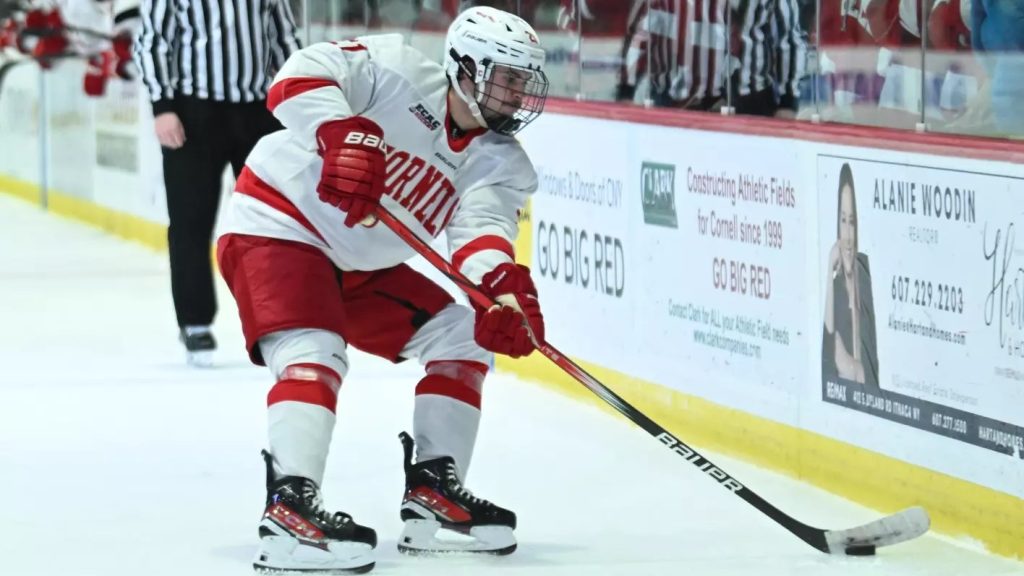
Each week during the season, we look at the big events and big games around Division I men’s college hockey in Tuesday Morning Quarterback.
Paula: Well, Dan, there’s a new No. 1 this week and I don’t think that anyone is surprised by that. What may be surprising is how many votes that new top team garnered for that position. There are other interesting narratives in this week’s poll as well.
With 38 first-place votes, Minnesota vaults from No. 4 to No. 1 in large part because of the Golden Gophers’ decisive sweep of visiting Michigan, two shutout wins against a team that had been averaging 4.00 goals per game (fourth nationally) prior to the series.
Nathan Airey and Liam Souliere each earned wins for the Gophers, with Airey stopping 32 in Friday’s 6-0 game and Souliere making 22 saves in Saturday’s 2-0 win. All six of Minnesota’s goals Friday night were scored even strength. Sam Rinzel’s game winner Saturday was a power-play goal and Jimmy Snuggerud added the empty netter in that game.
It’s just an impressive display, especially considering that the points that Minnesota earned in the sweep put the Gophers eight points ahead of second-place Wisconsin in the Big Ten, nine points ahead of third-place Michigan State — who just last week claimed 42 first-place votes to sit at No. 1 in that poll.
Boston College swept and is second in this week’s poll with six votes.
It’s interesting to me that Michigan State split with Wisconsin – a team that really struggled to get going this season – and fell to third while Denver split with a Western Michigan team that has been good all season, but the Pioneers are now in fourth place without a single first-place vote.
And Michigan only dropped from sixth to eighth, which tells me that poll voters are really paying attention to Minnesota now.
What stories does this week’s poll tell you, Dan?
Dan: Honestly, the poll gives me frustrations because I’m starting to see a blockade of teams that are preventing very good hockey teams from jumping into the rankings.
I have no problem with how the top of the poll is shaking down because I think those teams are unquestionably the best teams in the nation, and what we saw last year was a passing around of the No. 1 ranking torch. When Minnesota loses, Boston College will jump into the top spot until a loss sends Michigan State or Denver back into the top slot. Maine is a nice story but likely won’t make the jump (though I do account for one of the two first-place votes for the Black Bears), and a team like Western Michigan won’t ever grace the top of the poll unless the teams in front of it crater out.
I inherently don’t have a problem with that because those teams consistently win. I’m instead seeing a disconnect with how voters view the bottom of the poll. Like the top, a trend emerges for teams that don’t necessarily move throughout the rankings. UMass Lowell gradually worked its way up by going 10-3-2, but other teams won’t ever receive similar chances to move their way up the poll when teams like North Dakota, Quinnipiac and Arizona State are all occupying spots.
I think all of those teams are good teams, but I think a good chunk of teams simply have to win more frequently because they’re “not supposed to be there.” I think about teams like Clarkson, which is 11-5-2, or Bentley, which is 10-5-2.
The common response is that these teams don’t play the same caliber of opponent, and it’s proven in the PairWise, but Clarkson is six spots behind Cornell in the USCHO poll and four spots ahead of the Big Red in the Pairwise. Bentley is No. 29 in the Pairwise – right next to North Dakota, Cornell and Clarkson.
In the end, the PairWise winds up mattering at the end of the season, but I think I’m hitting the frustration point of the season where lesser-known teams don’t receive votes because they’re lesser-known teams. Do you agree or disagree with that assessment?
Paula: That is a good little rant-like passage, Dan, and I agree with you about the blockade. We’ve discussed this before, and there is deference given to teams that play in three specific conferences – and teams from the other three conferences have to work a lot harder to prove themselves.
The Big Ten, Hockey East and NCHC are consistently stronger conferences. That is a quantifiable thing. So far this season, B1G Hockey leads all conferences in nonleague play (.712 win percentage) followed by Hockey East (.694). NCHC (.587) and ECAC (.507) are the other two conferences above .500 for interconference win percentages.
The CCHA (.422) and Atlantic Hockey (.242) don’t provide evidence that bolsters confidence in the strengths of their leagues, but that shouldn’t mean that teams playing solid to excellent hockey in those conferences should be excluded completely.
I hear you. I no longer have Arizona State in my poll. In descending order, the bottom five on my ballot are North Dakota, Clarkson, Dartmouth, Quinnipiac and Bemidji State. I thought hard about Bentley, but with a six-game undefeated streak that included wins over Minnesota and North Dakota, the Beavers got my last spot.
Should Arizona State and North Dakota get more of the benefit of the doubt than, say, Bentley? If we’re looking at things that are quantifiable, I think it may.
Having said that, though, your comments had me checking the PWR, and at 26th, North Dakota is certainly in interesting company there right now. The five teams following the Fighting Hawks in the PWR are, in descending order: Bemidji, Bentley, Michigan Tech, Union, Wisconsin. How wild is it that the team currently sitting at 31st in the PairWise is also in second place in the Big Ten right now?
Looking at the PairWise Rankings, I’m intrigued by a lot of teams in the teens like New Hampshire, with its No. 14 spot and poll votes but not enough to crack the top 20. At No. 15 and with no AHA teams among the top 16 in the PWR, Dartmouth would be the cut-off if the season were to end today. That would leave Colorado College, Arizona State, Quinnipiac and Clarkson, all recognized in this week’s poll, out of the field. The distance between Colorado College’s poll placement and PRW ranking is wild – tied for 10th in the former and 19th in the latter.
Given all we’ve discussed here, Dan – the dominance of the top poll teams, the consistency of the teams that run from roughly No. 6 through No. 12, the relative strength of different leagues – how much of a chance do some of these teams below 20 in the PWR have of playing themselves into conference contention?
Ed Trefzger and Jimmy Connelly went into this a bit last week in the abstract, but the concrete – individual games, series, strength of schedule – is a wildcard, right? Last week, Ohio State was out. After sweeping a Penn State team significantly below them in the PWR, the Buckeyes are among the top 15.
Other than winning conference championships, what chance to good teams like Bentley and Bemidji State have, realistically? And is there anything you’d like to see tweaked in the formula?
Dan: It depends on how much I want to tear apart my own argument. Based on what I was saying, we logically would think that some of those teams should play themselves into contention by winning a championship.
A team like Cornell should play itself into postseason contention on the basis of being Cornell in ECAC, and ditto for North Dakota. Those were teams I thought would compete hard for a championship at the start of the year, so we should consider them among contenders for a conference championship.
Yet based on what I’m saying, the chasm between those top teams rotating around the No. 1 spot and the teams below them is growing significantly bigger. I don’t see Northeastern at No. 23 and think that it’s going to win the Hockey East championship when the strength of the conference is clearly in BC, Maine and Providence. Nor should I look at North Dakota, who seems to eat a ton of flack from me this week, and think that it’s a team that will overtake Western Michigan, Denver and St. Cloud. Heck, even Arizona State at 16 seems like a more logical spot than what I have right now.
Realistically, I’m all in on a tweaked field. For the longest time, I’ve been a proponent of using the mathematics as a guide but not as a be-all, and it’s gotten me into trouble on an annual basis because nobody wants to agree to move to the smoke-filled rooms of yesteryear. What I’m realizing, though, is that leagues carry significant freight when they’re bigger – with the exception of Hockey East – and that was a big reason why the old WCHA broke up and split apart to form the new CCHA.
Geography aside, we couldn’t help but notice that the three teams jettisoned included two of the lowest teams in the Pairwise Rankings around that time. Smaller leagues, while offering room for growth, can consolidate around winning more non-league games if it’s a league built around the more powerful teams.
Yet that’s the biggest issue. We don’t want to expand the national tournament, but access is locked because there are ways to use the collective strength to manipulate – I use that term in a good way – the numbers. I’m complaining without a solution, which is a big thing that angers me on a daily basis, but here I am.
Also worth bearing that I’d throw anyone out there for this, not just Bentley. Given my affiliation, I know it sounds suspect, but I’d actually argue that Bemidji deserves a bid over BU right now.
Paula: Dan, I enjoy when you throw shade – at specific teams, at the system, at yourself, even at me.
I agree that a solid argument could be made that Bemidji is playing better hockey right now than Boston University is, but that’s not the same thing as advocating for the Terriers to be tossed in favor of the Beavers. Not on my end anyway.
The poll, at least, gives people with knowledge of the game the opportunity to provide some perspective on what’s happening right now, rather than reducing all of it to math.
I am in favor of the math, for what it’s worth. I don’t miss the days of bubble-team coaches cornering me at tournaments and either making a plea for their squads – as though I ever had any influence – or ranting about their exclusion. The math is nice and neat.
What’s also, unfortunately, nice and neat is the haves-have nots world of college hockey. It’s been that way for the 30 years I’ve been covering, and back in the old CCHA days, I did a lot of throwing of shade myself.
You say it all when you say that we aren’t willing to expand the national tournament and that locks access. Yes, my friend. Yes.
But between now and the end of the season, there is a lot of hockey to played, as the old saying goes. I’m looking at the final week of first-half Big Ten play and I’m positively drooling. After those consecutive blankings in Minnesota last weekend, Michigan hosts Wisconsin, Michigan State travels to Minnesota and Ohio State hosts Notre Dame.
Following that, there’s an amazing lineup for the Great Lakes Invitational and the Frozen Confines in Wrigley Field should be fun.
I’m also looking forward to two off-brand (how’s that for shade) series this weekend, both in the NCHC: the home-and-home Colorado College-Denver series and the St. Cloud-North Dakota tilt.
What on-ice matches are you watching as this first half comes to a close, and what are you looking forward to during the holidays or as the second half starts up?
Dan: From a holistic perspective, I’m actually very much looking forward to seeing players start to separate themselves for the Hobey Baker Award over the next month or two. Given the talent that’s flowing, especially through those top teams, I think the race for the Hobey Hat Trick is loaded with electricity.
As for the rest of the year, I’m looking forward to leaving out the cookies and milk for the big fat man with the long white beard. He’s coming down my chimney in a few weeks – shoutout my kids – and marrying into an Italian Catholic family means I’ve got a full-fledged Feast of the Seven Fishes ahead of me!


